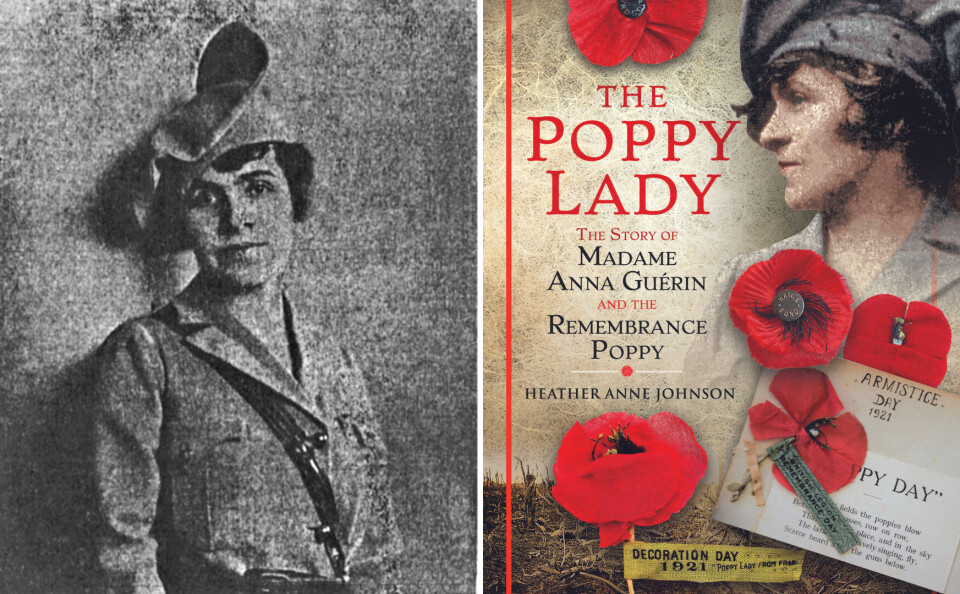-
One of the most notorious meals in the history of French gastronomy
How hard times inspired an outrageous festive feast in 1870
-
Brouage: inland fortified French village was once a major European salt port
Some 400,000 tourists visit every year - many of whom are Canadian
-
The Paris region has one of France’s ‘most beautiful’ villages
It is an official ‘plus beau village de France’
Poppy Lady of France recognised with a new biography in English
Anna Guérin, the Frenchwoman behind the Poppy Appeal, is largely unknown but a new book aims to redress that and show why the campaigner was such a trailblazer

In 2015, a Canadian woman asked Heather Johnson: “Who put that poppy on your lapel?”
Read more: How to buy a Remembrance Day poppy in France – or a bleuet
This simple question inspired her to delve into the history of Frenchwoman Anna Guérin, who Ms Johnson says has become a hero to her.
She published the first biography of Anna in October – The Poppy Lady.
‘Born before her time’
“Anna was born before her time,” Ms Johnson said.
“She was an independent woman and feminist who selflessly devoted part of her life to raising funds for French widows and orphans, combatants, not to mention the sick and the needy victims of the Great War, at a crucial time in history.
“There is much more to her, though. I wrote the book because I want more people to recognise this wonderful woman’s legacy and interesting life.”
Early years
Anna Alix Boulle was born on February 3, 1878, in Vallon-Pont-d’Arc in Ardèche.
Her protestant father was a farmer and respected member of the local community.
Anna’s education enabled her to become one of the most esteemed teachers in French Madagascar when she and her first husband Paul Rabanit moved there after marriage.
When they divorced in 1907, Anna returned to France and remarried in 1910, becoming Madame Guérin.
‘The greatest of all war speakers’
She began working for the Alliance Française in the UK, giving lectures about Madagascar and famous historical French women.
From 1914-18 she transferred to the US, arriving just after World War One began.
Discreetly, she spoke of the suffering in France and once the US joined the war, in April 1917, she openly lectured and raised funds for the war effort.
She was known as “the greatest of all war speakers” and reviews told of grown men crying during her talks.
Poppy Days
Following a brief return to France, Anna was sent back to the US after the war to form a new charity, the American-Franco Children’s League, providing help to French children in need.
In all the states she visited, Anna formed committees of influential people.
She gave advice on how to recruit fee-paying members and, as part of this, began to organise ‘Poppy Days’.
The idea of using a poppy as a symbol came from John McCrae’s poem ‘In Flanders Fields’, which Anna particularly liked.
Her first ‘Poppy Day’ was held in October 1919, in Baltimore. She personally bought artificial poppies for the event and, as always, funds were sent to France.
‘The Poppy Lady of France’
A year later, she began promoting her big idea, the Inter-Allied Poppy Day.
Women and children in devastated areas of France would be paid to make poppies to help families get back on their feet. Veterans’ organisations would order the poppies at cost price, which included a small amount for Anna’s children’s league, and keep the rest for their funds.
Anna explained this idea at the American Legion’s Convention in 1920 and it committed to supporting all of her ‘Poppy Days’, naming her ‘The Poppy Lady of France’.
In May 1921, in the US, Anna’s league held the world’s first national Poppy Day.
She then took her idea global, to Canada, New Zealand and the British Legion in London.
The Legion at the time was hard up and Anna financed its order of poppies and was reimbursed after the first Poppy Day on November 11, 1921.
The idea subsequently took off and the poppy remains a symbol of commemoration and hope worldwide.
Related articles
Why can I no longer order Remembrance Day items to France from UK?
Le Bleuet de France - origins of the French cornflower tradition
Did you know? First WW1 Tomb of the Unknown Soldier has French origins
























